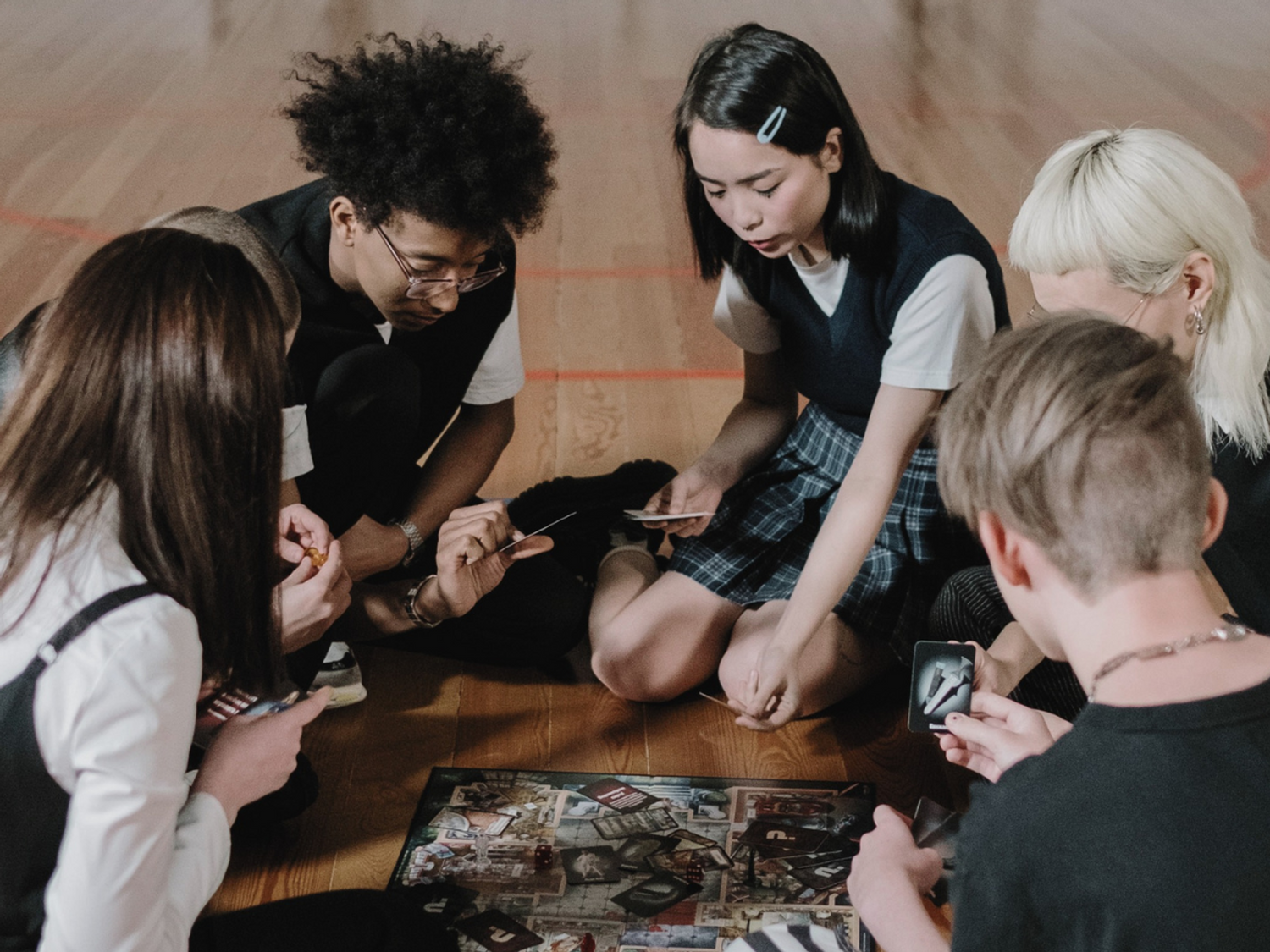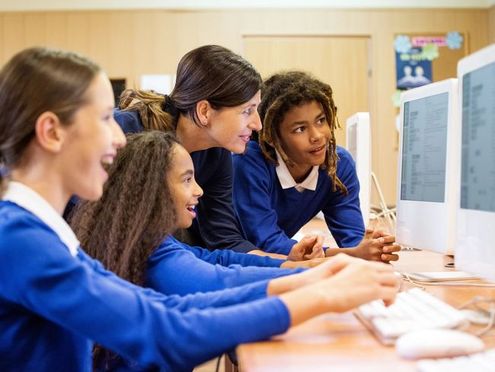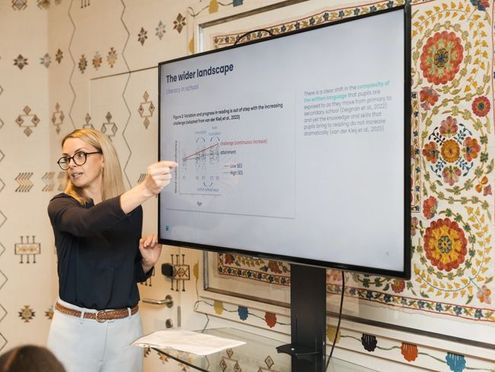What exactly is gamification and how is it used to bolster teaching and learning?
As technology continues to extend its reach and gaming becomes increasingly prominent in the everyday lives of so many people, gamification in education is also becoming more widespread as a strategy for engaging and motivating learners of all ages. New educational apps and games are springing up all the time that provide stimulating challenges, fun quests and engaging activities for children in tandem with the enduring popularity of video games, classic puzzles, board games and role-playing games. Using the key features employed in games to create interactive resources that promote positive learning outcomes is a teaching method that is becoming ever more popular and effective in the classroom.
In this blog, we will be exploring what gamification is and its role in teaching and learning, the key educational benefits it offers learners, how you can use gamification to your advantage as a teacher, and how Bedrock incorporates gamification into our literacy curricula.
What is gamification?
Gamification is the process of importing the strategies and design features of games into non-gaming situations. The term gamification was first devised by game designer Nick Pelling in 2002, but the word didn’t become widely used until 2010. Gamification retains the same four fundamental principles of games, which are: goals, rules, feedback system, and voluntary participation. It is a means of recreating the fun, challenging and interactive aspects of games to achieve certain aims. This could include presenting information more interestingly, sharpening skills, improving knowledge or simply giving the participants a confidence boost and a feeling of accomplishment.
This approach can be used to great effect in a variety of settings and gamification is playing an increasingly valuable role in education due to the broad appeal it has for children. Gamification in education seeks to improve learner motivation and engagement by providing an enjoyable and varied learning experience which aims to increase positive learning outcomes. By using gamification to restructure more traditional teaching methods, teachers can find new ways to connect with learners, diversify lessons and improve retention.
Why does gamification matter in education?
According to the Children’s Commissioner (2019), 93% of children participate in gaming in one form or another. When it is enjoyed as part of a balanced lifestyle and it does not risk becoming an overly dominant activity in a child’s life, there are many positive aspects of gaming for children. This can include the development of core literacy, numeracy and problem-solving skills, and if they are playing games with others, it also contributes to increasing their level of interaction and cooperation with peers, working as part of a team, enhancing their social skills, and developing their ability to build effective relationships and empathise with others.
As the overwhelming majority of children regularly play games, it stands to reason that incorporating the positive elements of gaming and strategies utilised in games into education will pique their interest, increase their engagement, stimulate their curiosity and maintain the desired level of focus and motivation on the task or topic. Replicating the vocabulary and reward systems used in games, and offering points, badges or prizes for completing quests, progressing to the next level or unlocking achievements can be used to incentivise children effectively and propel them forwards in their learning journey. If a lesson or a new skill is presented in the same way as a game that they are familiar with, it will increase the learners’ desire to make progress in order to feel a similar level of satisfaction that they experience when they are playing one of their favourite games for fun.
Learners are bound to feel more of a connection with a resource or medium that they are interested in, and they prefer activities that they feel challenged by in a way that is exciting and appealing, rather than daunting. If educational material is presented in the format of a game that learners like and are familiar with, they are much more likely to engage with the information and get the most out of the learning experience.
Gamification offers a fresh avenue for presenting subject material in a manner that is relevant, current and in line with children’s preferred methods of processing information. Setting out clear goals and incentives for each task that is completed will further fuel the learners’ desire to complete the ‘quest’ and accomplish the goals set out for them, whether it is learning a certain number of new subject-specific words, selecting the correct facts about a historical figure, accurately mapping out a scientific process or solving a mathematical puzzle.
Examples of gamification in learning
There are many notable features of gaming and adaptations of classic games that are ideal for use in the classroom and at home. The rich array of themes and formats to choose from allows plenty of scope for developing creative lesson plans, immersive resources, and materials and themes that are suitable for different subjects and learning styles.
Apps and digital learning platforms
There are lots of great educational apps and digital learning platforms in existence today that have found new ways to connect with and motivate learners, complement traditional classroom teaching, and promote independent learning. Whether it is learning a new language with Duolingo, improving literacy skills with Bedrock or brushing up on subject-specific knowledge with Kahoot, these platforms can be easily accessed on any device. Apps such as these break down learning into manageable chunks, allowing users to set themselves realistic goals and offer incentives and reminders to ensure learners stay on track. They present information using the same appealing, user-friendly and immersive formats found in online games.

Start a Bedrock free trial
Your students can earn points, encouraging healthy competition and entering prize draws!
Quizzes, puzzles and word games
Whether you choose to make digital or physical resources, you can adapt the classic format of familiar quizzes, puzzles and word games to enhance learning in literacy, as well as to improve numeracy skills and the retention of subject-specific knowledge. Using a format similar to Scrabble or Boggle, or simply making your own crosswords and word searches, can be a great resource for teaching literacy. Creating your own Trivial Pursuit-style quiz or taking inspiration from a certain game show format, for example, are also fun and impactful ways of getting children to learn and memorise key facts about specific topics.
Board games and role-playing
Most children will have played board games in some form at home with their families as an enjoyable bonding exercise that everyone can get involved in. This familiar format is great fun to use in the classroom to sharpen subject knowledge, develop critical thinking abilities, and hone literacy and numeracy skills.
Similarly, a role-playing game such as Dungeons and Dragons, which has seen a resurgence in popularity amongst younger people thanks to the Netflix show Stranger Things, provides the same opportunity for group participation and the scope to develop a range of different skills and areas of knowledge. It is a great format to adapt for teaching history or literature, for example, as well as for developing wider skills such as strategic and creative thinking, problem-solving, collaboration, leadership, empathy, and even Tier 2 and 3 vocabulary.
What benefits does gamification have?
Although a lot of further research is required on the positive impact of gamification in learning to fully appreciate the extent of its role, evidence indicates that it offers a range of advantages. When used effectively, gamification can provide a wealth of benefits for children in their academic, personal and social development, their ability to retain knowledge, their achievement of learning outcomes and in improving their sense of well-being.
Increasing learner motivation and engagement
Presenting a task or topic in the form of a game provides an enjoyable experience that children want to immerse themselves in and stay focused on to complete the challenge.
Creating a positive learning environment
Gamification can increase the level of participation, engagement and interaction between learners, which helps to create an upbeat and inclusive atmosphere in the classroom.
Aiding knowledge retention
Being immersed in a fun activity makes children naturally more receptive to the information within it and more likely to retain what they are learning, especially if they need to remember key pieces of information to make progress and receive rewards.
Promoting accessible learning
Whether it is a task on a digital platform that can be readily accessed on any device either at school or at home, or a simple literacy or numeracy activity that only requires basic materials such as paper and coloured pens, gamification can open up learning for everyone and make it much easier for children to participate outside of the classroom too.
Improving both cognitive and physical development
Tasks that require the deployment of factual knowledge, selecting the correct words and working out mathematical puzzles, for example, can improve concentration, memorisation and critical thinking skills. More physical activities can contribute to children’s fitness, dexterity, and hand-eye coordination skills.
You can read more about the benefits of and science behind gamification in the classroom here.
How can teachers use gamification effectively in the classroom?
There are many positive elements to the design and purpose of various games that can be incorporated into classroom activities to promote learner engagement, achieve learning outcomes and give learners a dynamic and interactive experience that they will be eager to repeat in class or replicate at home.
Gamification can provide plenty of inspiration to help you to take a fresh and creative approach to the format of lessons and develop resources to pique your learners’ interest, increasing their engagement by presenting topics in a more accessible, fun and immersive format.
Turning objectives into quests
Adopting certain aspects of gaming vocabulary during lessons can make achieving learning outcomes sound like an appealing challenge for your learners by presenting objectives as quests to complete and achievements to unlock. Most learners will already be very familiar with this terminology through their own time spent gaming and will respond positively to it. When used appropriately, this style of motivational vocabulary can give your learners the extra drive to succeed.
Increasing motivation with rewards
Giving incentives such as awarding points, stamps, stickers, or even small prizes encourages learners to stay focused and continue making progress towards achieving the goals you have set for them, as well as enhancing their sense of accomplishment when they have completed each stage of the task.
Encouraging healthy competition
A healthy dose of competition is always an effective way of motivating learners, whether it is as individuals or as part of a team. Giving learners a sense of satisfaction when they see their name move up the leader board, score the most points or win a round can stimulate their desire to learn and progress. It is also an effective way of encouraging learners to be supportive of their peers, harnessing the emotional benefits of being happy for others when they succeed.
How does Bedrock incorporate gamification into its teaching?
One of the most effective methods of gamifying a digital curriculum is the use of points to reward learning - this is something Bedrock’s core curriculum does. Whatever learners do to progress their learning on Bedrock, whether it’s completing a recap activity or finishing an entire Block - they are rewarded Bedrock points. Learners who earn 20 points or more per week are entered into a half-termly prize draw where they are in the running to win one of fifty Amazon vouchers or two Chromebooks. As well as this prize draw, Bedrock points can be used as an indicator to inform leaderboards and in-school competitions, linking gamification online to the classroom.
As well as this, Bedrock’s contextualising activities draw from online games to keep learning engaging and fun. Learners strengthen their understanding of synonyms and antonyms by throwing paper into the bin and or drafting text messages to friends using new literacy techniques. These methods draw on the benefits of gamification to strengthen learners’ literacy skills and promote independent learning.
Summary
Whether it is through an app, a class activity or independent participation at home, presenting educational material in the format of a game makes learning fun and rewarding for teachers, learners and parents. Identifying the elements that make games so appealing, enjoyable and compelling to play, and adapting their format and features for use in teaching is a brilliant way of engaging with your learners and motivating them to achieve their learning objectives, as well as having a positive impact on their social and emotional development.
When used to complement traditional classroom teaching, gamification in learning offers a range of benefits and opportunities for learners to develop their skills and knowledge, experience a feeling of achievement when they reach their goals, improve their sense of well-being and above all, have fun whilst they are doing it.




